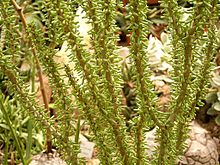Ceraria namaquensis: Difference between revisions
m added R cat |
Redirected in wrong direction Tag: Removed redirect |
||
| Line 1: | Line 1: | ||
{{taxobox |
|||
| ⚫ | |||
| image = Ceraria mamaguensis - Tower Hill Botanic Garden.JPG |
|||
| regnum = [[Plant]]ae |
|||
| unranked_divisio = [[Angiosperms]] |
|||
| unranked_classis = [[Eudicots]] |
|||
| unranked_ordo = [[Core eudicots]] |
|||
| ordo = [[Caryophyllales]] |
|||
| familia = [[Didiereaceae]] |
|||
| genus = ''[[Ceraria]]'' |
|||
| species = '''''C. namaquensis''''' |
|||
| binomial = ''Ceraria namaquensis'' |
|||
| binomial_authority = (Sond.) H.Pearson & Stephens |
|||
| synonyms = |
|||
| ⚫ | |||
*''Ceraria gariepina'' {{au|H.Pearson & Stephens}} |
|||
}} |
|||
'''''Portulacaria namaquensis''''', with the common names '''Namaqua porkbush''' and '''Namaqua portulacaria''', is a [[species]] of succulent shrub, native to the border between [[South Africa]] and [[Namibia]].<ref>{{Cite web|url=http://www.theplantlist.org/tpl1.1/record/kew-232786|title=Ceraria namaquensis (Sond.) H.Pearson & Stephens — The Plant List|website=www.theplantlist.org|language=en|access-date=2017-08-02}}</ref> |
|||
{{R from alternative scientific name|plant}} |
|||
<ref>{{Cite web|url=http://eol.org/pages/5224043/overview|title=Ceraria namaquensis - Overview - Encyclopedia of Life|website=Encyclopedia of Life|language=en|access-date=2017-08-02}}</ref> |
|||
<ref>[http://plants.jstor.org/stable/10.5555/al.ap.visual.preart0003071 JSTOR entry: ''Ceraria namaquensis'']</ref> |
|||
Formerly '''''Ceraria namaquensis''''', The plant's current name is '''''Portulacaria namaquensis''''', due to recent phylogenetic studies have shown that it is in fact located within the genus ''[[Portulacaria]]''.<ref name=bruyns>P.Bruyns, M.Oliveira-Neto, G.F. Melo de Pinna, C.Klak: ''Phylogenetic relationships in the Didiereaceae with special reference to subfamily Portulacarioideae''. Taxon 63 (5). October 2014. 1053-1064.</ref> |
|||
Its closest relative is the species ''[[Portulacaria armiana]]''<ref name=bruyns/><ref>{{Cite web|url=http://www.cactus-art.biz/schede/CERARIA/Ceraria_namaquensis/Ceraria_namaquensis/Ceraria_namaquensis.htm|title=Ceraria namaquensis|website=www.cactus-art.biz|access-date=2017-08-02}}</ref> |
|||
==Distribution== |
|||
The natural habitat of this species extends along the [[Orange River]] valley, along the border between Namibia and South Africa. It has also been recorded near the coast slightly further north in Namibia.<ref>''Annals of the South African Museum'' 9: 33. 1912. (Ann. S. African Mus.)</ref> |
|||
This is an extremely arid, winter-rainfall area. In cultivation, it requires extremely well-drained soil, and is usually grown grafted onto a root-stock of the more resilient ''[[Portulacaria afra]]''. |
|||
==Description== |
|||
[[File:Ceraria namaquensis 03 ies.jpg|thumb|left|Detail of the distinctive leaves]] |
|||
It reaches heights of 1.3 to 1.8 meters, and typically has small, ovoid, club-shaped leaves. |
|||
These succulent leaves are deciduous, and densely coat its stems. The stems are stout and grow upwards, forking. They are very slow-growing. Its flowers are usually unisexual. |
|||
==References== |
|||
{{Reflist|26em}} |
|||
==External links== |
|||
* [http://en.hortipedia.com/wiki/Ceraria_namaquensis Hortipedia entry for ''Ceraria namaquensis''] |
|||
{{Commonscat|Portulacaria namaquensis|position=left}} |
|||
{{Taxonbar|from=Q17244710}} |
|||
{{-}} |
|||
[[Category:Didiereaceae]] |
|||
[[Category:Portulacaria|namaquensis]] |
|||
[[Category:Flora of Namibia]] |
|||
[[Category:Flora of South Africa]] |
|||
[[Category:Garden plants of Africa]] |
|||
[[Category:Succulent plants]] |
|||
Revision as of 06:02, 1 April 2018
| Ceraria namaquensis | |
|---|---|

| |
| Scientific classification | |
| Kingdom: | |
| (unranked): | |
| (unranked): | |
| (unranked): | |
| Order: | |
| Family: | |
| Genus: | |
| Species: | C. namaquensis
|
| Binomial name | |
| Ceraria namaquensis (Sond.) H.Pearson & Stephens
| |
| Synonyms | |
| |
Portulacaria namaquensis, with the common names Namaqua porkbush and Namaqua portulacaria, is a species of succulent shrub, native to the border between South Africa and Namibia.[1] [2] [3]
Formerly Ceraria namaquensis, The plant's current name is Portulacaria namaquensis, due to recent phylogenetic studies have shown that it is in fact located within the genus Portulacaria.[4]
Its closest relative is the species Portulacaria armiana[4][5]
Distribution
The natural habitat of this species extends along the Orange River valley, along the border between Namibia and South Africa. It has also been recorded near the coast slightly further north in Namibia.[6]
This is an extremely arid, winter-rainfall area. In cultivation, it requires extremely well-drained soil, and is usually grown grafted onto a root-stock of the more resilient Portulacaria afra.
Description

It reaches heights of 1.3 to 1.8 meters, and typically has small, ovoid, club-shaped leaves.
These succulent leaves are deciduous, and densely coat its stems. The stems are stout and grow upwards, forking. They are very slow-growing. Its flowers are usually unisexual.
References
- ^ "Ceraria namaquensis (Sond.) H.Pearson & Stephens — The Plant List". www.theplantlist.org. Retrieved 2017-08-02.
- ^ "Ceraria namaquensis - Overview - Encyclopedia of Life". Encyclopedia of Life. Retrieved 2017-08-02.
- ^ JSTOR entry: Ceraria namaquensis
- ^ a b P.Bruyns, M.Oliveira-Neto, G.F. Melo de Pinna, C.Klak: Phylogenetic relationships in the Didiereaceae with special reference to subfamily Portulacarioideae. Taxon 63 (5). October 2014. 1053-1064.
- ^ "Ceraria namaquensis". www.cactus-art.biz. Retrieved 2017-08-02.
- ^ Annals of the South African Museum 9: 33. 1912. (Ann. S. African Mus.)
